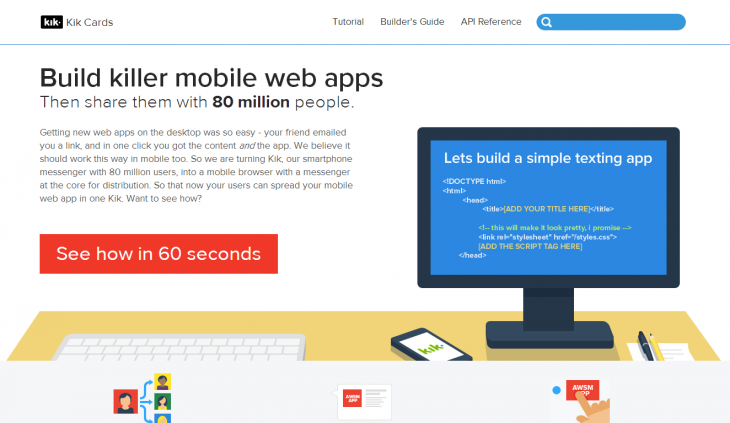
Mobile messaging service Kik has quietly taken a significant step forward after it opened its ‘Cards’ content platform to third-party developers.
Canada-based Kik introduced the HTML5 content platform in November 2012 as a way to bring multimedia and advanced features — such GIFs, video search/sharing and games — to its then text chat-focused iOS and Android apps. Now, after keeping content development in-house for nearly a year, any developer can create Cards for the service, which has over 90 million registered users.
The Cards feature appears to have been opened to third-parties sometime within the past week, and — like the introduction of Kik’s first games in July — it was made without a formal announcement and the company declined to comment when we got in touch.
Kik is one of a number of messaging firms going beyond just text chatting but unlike US rival Tango, Asia’s Kakao Talk and Line, and others, Kik’s platform supports HTML5-based Web apps rather than offering an SDK for standalone apps or games.
That approach may be simpler, but it is far from basic: developers have access to a range of APIs that tap into the Kik user graph, messaging platform and push notifications to help give their apps reach and engagement.
Speaking to TNW last year, Kik CEO and co-founder Ted Livingston explained that the simplicity of HTML5 was a key reason behind its adoption, and indeed documents on the Cards website promise to walk developers through the process in just sixty seconds.
Other multimedia-rich messaging apps typically position their services as content platforms, but — interestingly — Kik refers to itself as “a mobile browser with a messenger at the core for distribution,” and there are some subtle, but interesting differences.
Aside from aiming to make developers’ lives easier, the Cards platform is also designed with the user experience in mind. Not only is the feature tucked neatly away, requiring a side swipe to open, but Kik Cards themselves are located and installed within the app — that’s unlike standalone messenger games which require a separate (and sometimes time-consuming) download from an app store.
There are currently more than 30 Cards available, each of which was developed by Kik — now that the platform is open to all, it will be interesting to see how quickly further content arrives and widens the functionality available.
Developers who are interested in creating or porting services and applications to Kik can visit the dedicated Cards site, which contains a comprehensive selection of materials about the platform and how apps can hook into it. For now, it seems that there is no option to create paid-for Cards, but the opening of the platform does raise the possibility that Kik will begin making money via revenue sharing in the future.
Related: Ted Livingston’s rollercoaster ride as CEO of hit messaging startup Kik
Headline image via Parkpoom Chulapoomphinit / Shutterstock
Get the TNW newsletter
Get the most important tech news in your inbox each week.






